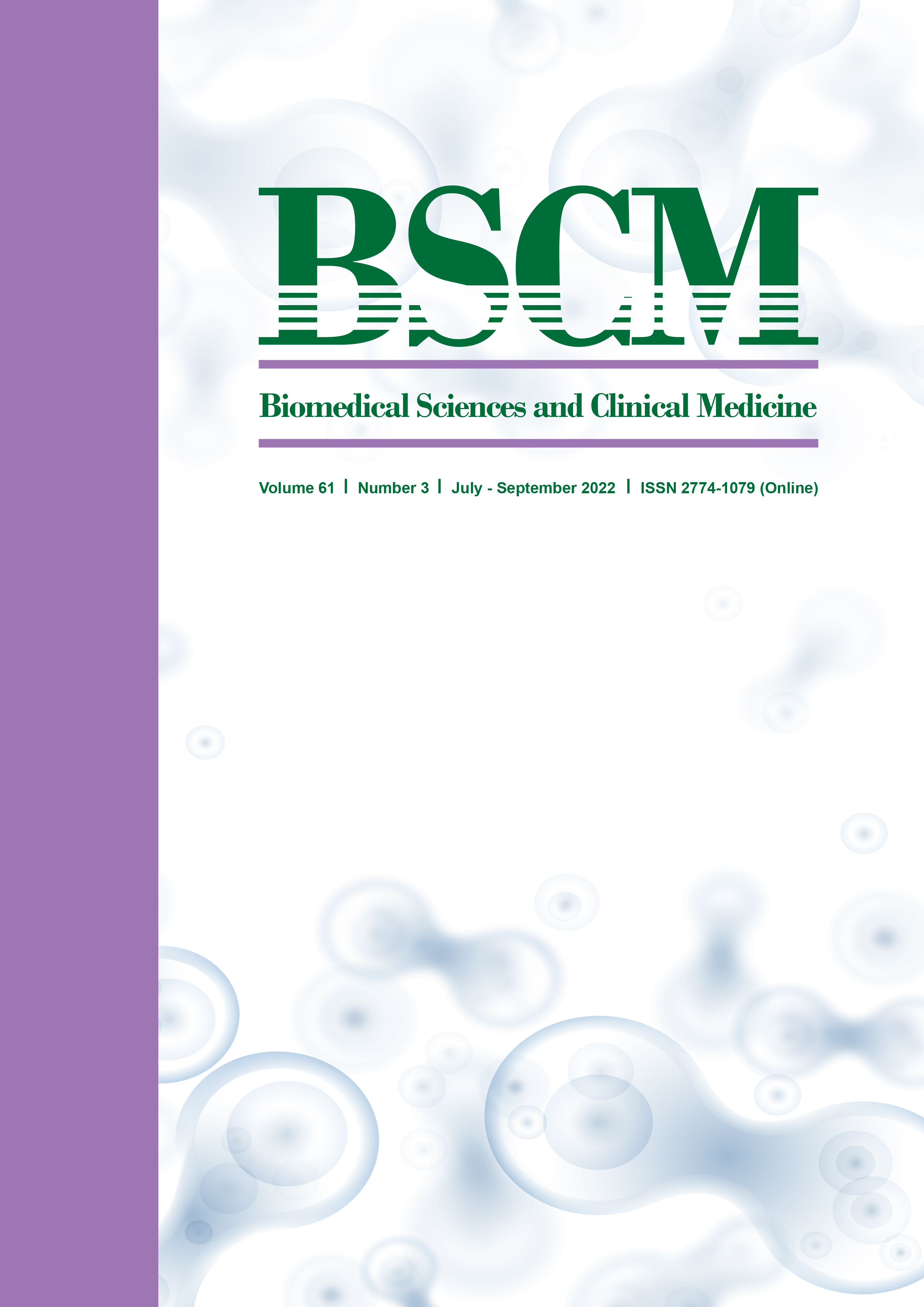Medication Errors in Ready-to-Administer Injectable Admixtures Compounded by Pharmacy Personnel: A Study of Hospitals in Northern Thailand
Keywords:
medication errors, ready-to-administer injection, pharmacistAbstract
OBJECTIVE To determine the number, types, and severity of medication errors in ready-to-administer injectable admixtures compounded by pharmacy personnel in northern Thai hospitals.
METHODS This retrospective descriptive study was conducted in six hospitals in northern Thailand. Data were gathered from hospital incidence reports over the three-year period 2017-2019. The following data were extracted from each report: stage of error, medication involved, care setting, and severity of error. The National Coordinating Council for Medication Error Reporting and Prevention index was used to categorize the severity of the medication errors. Results are presented as number and percentage.
RESULTS The total number of medication error events in the six hospitals was 405, classified as transcribing (n=59, 14.5%), pre-dispensing (n=217, 53.6%) and dispensing errors (n=129, 31.9%). The most frequent type of pre-dispensing errors was inappropriate techniques in medication compounding (n= 54, 13.3%). Almost all the medication errors were of severity level B (errors resulting in no harm to patients) (n=398, 98.3%). The most frequent errors were reported in antineoplastic agents (n=373, 92.1%).
CONCLUSIONS The great majority of medication errors were pre-dispensing errors with a low level of severity. The provision of strategies to prevent medication errors is necessary for patient safety.
References
Shane R. Current status of administration of medi-cines. Am J Heal Pharm. 2009;66(5 Suppl3):S42-8.
Ong WM, Subasyini S. Medication errors in intra-venous drug preparation and administration. Med J Malaysia. 2013;68:52-7.
Hermanspann T, van der Linden E, Schoberer M, Fitzner C, Orlikowsky T, Marx G, et al. Evaluation to improve the quality of medication preparation and administration in pediatric and adult intensive care units. Drug Healthc Patient Saf. 2019;11:11-8.
Fahimi F, Ariapanah P, Faizi M, Shafaghi B, Nam-dar R, Ardakani MT. Errors in preparation and administration of intravenous medications in the intensive care unit of a teaching hospital: an ob-servational study. Aust Crit Care. 2008;21:110-6.
Abbasinazari M, Talasaz AH, Mousavi Z, Zare-To-ranposhti S. Evaluating the frequency of errors in preparation and administration of intravenous medications in orthopedic, general surgery and gastroenterology wards of a teaching hospital in Tehran. Iran J Pharm Res. 2013;12:229-34.
Prot S, Fontan JE, Alberti C, Bourdon O, Farnoux C, Macher MA, et al. Drug administration errors and their determinants in pediatric in-patients. Int J Qual Heal Care. 2005;17:381-9.
Vijayakumar A, Sharon E, Teena J, Nobil S, Nazeer I. A clinical study on drug-related problems asso-ciated with intravenous drug administration. J Ba-sic Clin Pharm. 2014;5:49-53.
Vazin A, Delfani S. Medication errors in an internal intensive care unit of a large teaching hospital: a direct observation study. Acta Med Iran. 2012;50: 425-32.
Wirtz V, Taxis K, Barber ND. An observation-al study of intravenous medication errors in the United Kingdom and in Germany. Pharm World Sci. Pharm World Sci. 2003;25:104-11.
Joint Commission International. Joint Commis-sion International Accreditation Standards for Hospitals. 7th ed. Illinois (US): Joint Commission Resources; 2020. p. 424.
Morris AM, Schneider PJ, Pedersen CA, Mirtallo JM. National survet of quality assurance activities for pharmacy-compounded sterile preparations. Am J Health Syst Pharm. 2003;60:2567-76.
Webster CS, Merry AF, Gander PH, Mann NK. A prospective, randomised clinical evaluation of a new safety-orientated injectable drug adminis-tration system in comparison with conventional methods. Anaesthesia. 2004;59:80-7.
American Society of Health System Pharmacists. ASHP Guidelines on compounding sterile prepa-rations. Am J Health Syst Pharm. 2014;71:145-66.
Noparatayaporn P, Thaweethamcharoen T, Lao-charoenkeat A, Narkchuay P, Klinniyom A, Nop-maneejumruslers C, et al. Economic evaluation of ready-to-use injectable medications by pharmacy department compared with the traditional system of individual preparation by nurse. Siriraj Med J. 2019;71:25-30.
Hartwig SC, Denger SD, Schneider PJ. Severi-ty-indexed, incident report-based medication error-reporting program. Am J Hosp Pharm. 1991; 48:2611-6.
Ramírez-Camacho MA, Lara Aké NJ, Puga Tuyub GA, Torres-Romero JC. Medication errors of intra-venous therapy in the neonatal intensive care unit of a second-level hospital in southeastern Mexico. Lat Am J Pharm. 2020;39:604-11.
Anacleto TA, Perini E, Rosa MB, César CC. Drug-dispensing errors in the hospital pharmacy. Clinics. 2007;62:243-50.
Nguyen HT, Pham HT, Vo DK, Nguyen TD, Van Den Heuvel ER, Haaijer-Ruskamp FM, et al. The effect of a clinical pharmacist led training programme on intravenous medication errors: a controlled before and after study. BMJ Qual Saf. 2014;23:319-24.
Soontornpas R, Boonlue T, Kulvarotama S, Soon-tornpas C. Monitoring of near miss error by pre-dispensing recheck at out-patient pharmacy service, Department of Pharmacy, Srinagarind Hospital. Srinagarind Med J. 2012;27(Suppl):150-1. (In Thai)
Kruerut P. The development of preventing medi-cation error for patient safety in Bannasan hospi-tal. Region 11 Medical Journal. 2018;32:871-80. (In Thai)
Lynskey D, Haigh SJ, Patel N, Macadam AB. Med-ication errors in community pharmacy: an inves-tigation into the types and potential causes. Int J Pharm Pract. 2007;15:105-12.
Taxis K, Barber N. Causes of intravenous medica-tion errors: an ethnographic study. Qual Saf Heal Care. 2003;12:343-7.
Flynn EA, Pearson RE, Barker KN. Observation-al study of accuracy in compounding i.v. admix-tures at five hospitals. Am J Health-Syst Pharm. 1997;54:904-12.
Nguyen HT, Nguyen TD, Van Den Heuvel ER, Haa-ijer-Ruskamp FM, Taxis K. Medication errors in Vietnamese hospitals: prevalence, potential out-come and associated factors. PLoS One. 2015;10:1-12.
Tavakoli-Ardakani M, Omidi S, Eshraghi A, Salamzadeh J. Medication errors in administra-tion of chemotherapeutic agents: an observational study. Iran J Pharm Sci. 2013;9:1-11.









